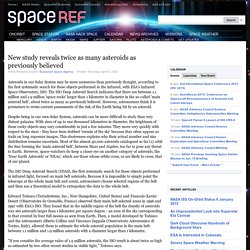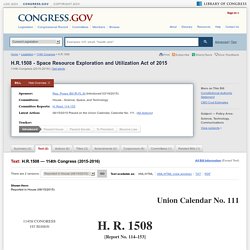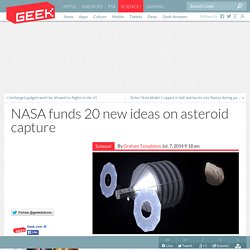

Asteroid mining. Artist's concept of asteroid mining Asteroid mining is the exploitation of raw materials from asteroids and other minor planets, including near-Earth objects.[1] Minerals and volatiles could be mined from an asteroid or spent comet then used in space for in-situ utilization (e.g. construction materials and rocket propellant) or taken back to Earth.

These include gold, iridium, silver, osmium, palladium, platinum, rhenium, rhodium, ruthenium and tungsten for transport back to Earth; and iron, cobalt, manganese, molybdenum, nickel, aluminium and titanium for construction, water, and oxygen to sustain astronauts, as well as hydrogen, ammonia, and oxygen for use as rocket propellant. Purpose[edit] In 2006, the Keck Observatory announced that the binary Jupiter trojan 617 Patroclus,[12] and possibly large numbers of other Jupiter trojans, are likely extinct comets and consist largely of water ice.
Asteroid selection[edit] Asteroid cataloging[edit] Mining considerations[edit] Surface mining[edit] Japan Is Launching An Asteroid Mining Space Program. Asteroid mining and space law: Who gets to profit from outer space platinum? Photo illustration by Juliana Jiménez Jaramillo.

Photos by Getty Images/NASA/Creative Commons There’s gold in them thar skies, or at least some platinum and a substantial amount of water, according to hopeful space prospectors. Over the past several years, a few companies have announced plans to mine asteroids. If successful, they could reinvigorate earthbound industries with infusions of rare earth minerals. Dean Larson: Mining Asteroids and Exploiting the New Space Economy. How Asteroid Mining Will Work - HowStuffWorks. If you enjoy science fiction, then you know that the thought of colonizing the moon makes for some incredibly imaginative stories.

But there is a good possibility that lunar cities will become a reality during the 21st century! Colonizing Mars is another option as well. Right now, one of the biggest problems with the idea of a moon colony is the question of building supplies. There is no Home Depot on the moon, so the building supplies have to come from somewhere.
The only place to get the supplies right now is the Earth, with the space shuttle acting as a truck. Asteroids may be a much better place to get the supplies. Univerzita Karlova v Praze - Aktuality. O asteroidech se v posledních letech stále častěji uvažuje jako o zdroji nerostných surovin.

New study reveals twice as many asteroids as previously believed. Asteroids in our Solar System may be more numerous than previously thought, according to the first systematic search for these objects performed in the infrared, with ESA's Infrared Space Observatory, ISO.

The ISO Deep Asteroid Search indicates that there are between 1.1 million and 1.9 million 'space rocks' larger than 1 kilometre in diameter in the so-called 'main asteroid belt', about twice as many as previously believed. However, astronomers think it is premature to revise current assessments of the risk of the Earth being hit by an asteroid. Despite being in our own Solar System, asteroids can be more difficult to study than very distant galaxies.
New Class of "Easily Retrievable" Asteroids Discovered. Asteroids that pass close to Earth have become the focus of increased attention in recent years, partly because of the potential threat they pose to humanity.

But they are also a potential boon. For decades, science fiction writers and various space scientists have pointed out that asteroids offer a huge untapped source of valuable resources. Bringing just a small portion of this back to Earth could be a game changer for our planet. And even if this stuff is too expensive to bring home, it could provide the raw materials for rocket fuel and perhaps even rockets themselves to be manufactured in space. Many visionaries have greedily eyed these resources in the hope that a new gold rush is just around the corner. Get Ready for the Asteroid Gold Rush. Text - H.R.1508 - 114th Congress (2015-2016): Space Resource Exploration and Utilization Act of 2015. Union Calendar No. 111 [Report No. 114–153] To promote the development of a United States commercial space resource exploration and utilization industry and to increase the exploration and utilization of resources in outer space.

Be it enacted by the Senate and House of Representatives of the United States of America in Congress assembled, SEC. 1. Short title. This Act may be cited as the “Space Resource Exploration and Utilization Act of 2015”. SEC. 2. (a) In general. Home - Planetary ResourcesPlanetary Resources. Luxembourg boldly invests in asteroid mining - Video - Technology. NASA chce ulovit asteroid, má již třetí potenciální oběť.
NASA financuje 20 nápadů, jak realizovat zachycení asteroidu. NASA funds 20 new ideas on asteroid capture. NASA is taking a distributed approach to its newest super-project, bringing in 20 outside research groups to help tackle capturing an asteroid.

The goal is to capture a passing space rock and move it into orbit around our Moon, and eventually to remove a large portion of that rock and transport the sample back to Earth. This whole multi-stage process will act as a dry run to help NASA engineers work through any early problems with a future manned mission to Mars. By getting so many different teams working on this problem all at once, NASA hopes they can start launching missions to our new moon-of-a-moon by the year 2025. The 20 new studies are divided into five basic groups: Asteroid capture, asteroid rendezvous, adaptation of modern spacecraft for the redirect, secondary mission objectives, and help with future lunar missions.
The most sensational of these are groups 1 and 3 — the actual capture and redirection of the asteroid. Announces Latest Progress, Upcoming Milestones in Hunt for Asteroids. [image-36] NASA is on the hunt for an asteroid to capture with a robotic spacecraft, redirect to a stable orbit around the moon, and send astronauts to study in the 2020s -- all on the agency's human Path to Mars.

Agency officials announced on Thursday recent progress to identify candidate asteroids for its Asteroid Redirect Mission (ARM), increase public participation in the search for asteroids, and advance the mission's design. NASA plans to launch the ARM robotic spacecraft in 2019 and will make a final choice of the asteroid for the mission about a year before the spacecraft launches.